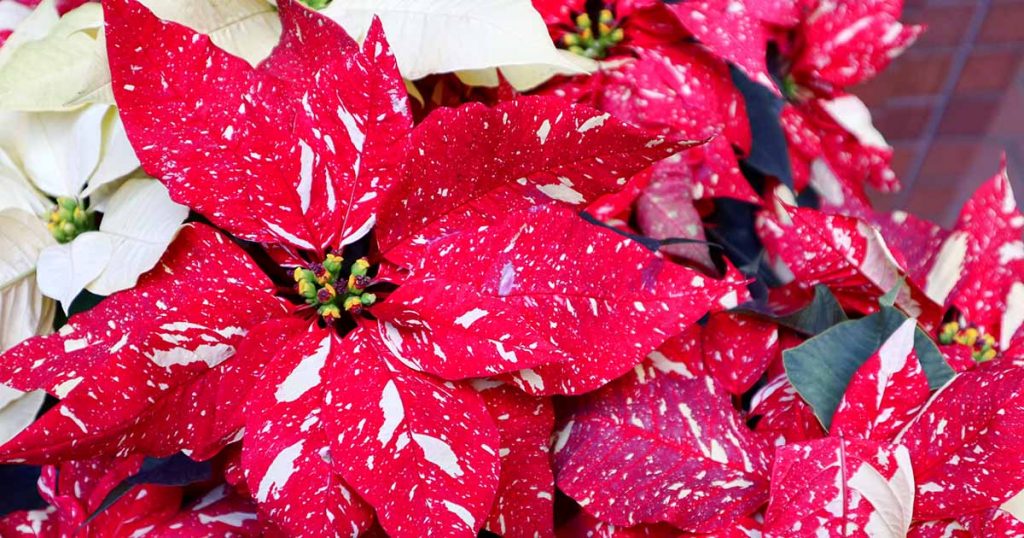Like the panettone, fairy-lit tree and nativity scene, the bright red flower known in Italy as the stella di Natale is synonymous with Christmas in most Italian households.

In 1833, German botanist and director of the Berlin botanical gardens Karl Ludwig Wilenow assigned the scientific name, euphorbia pulcherrima, meaning “very beautiful euphorbia”, to this species. Part of the Euphorbiaceae family, the poinsettia is a flowering shrub that, in nature, can grow as tall as three meters. Mistakenly, many think that the coloured parts of the plant are the flowers. Instead, they are actually coloured bracts or modified leaves. The flowers, or cyathia, are the yellow centre of the bracts, which can range in colour from their familiar flaming red to pink, orange, pale green, cream, white or marbled. The colour comes from a process called photoperiodism, which means the plant must stay in darkness for at least 12 hours each day to change colour and flower.
The plant was originally native to Taxco in Mexico; the Aztecs called it cuetlaxochitl, meaning “the flower of leather petals” and believed it symbolised the blood of the human sacrifices they made to the sun god. They used its milky sap in medicines and its leaves in making dye. On his arrival in Tenochtitlan (now Mexico City) in November 1519, the Spanish conquistador Hernando Cortez realised that Montezuma, the last Aztec king, who used these flowers to decorate his palace, had them transported to his capital by caravan as they would not grow at high altitude. Soon, the Spanish missionaries had baptised the plant the Stella di Natale, because not only was it at its full splendour at Christmastime but the star-shaped leaves call to mind the star of Bethlehem and the crimson colouring the sacrifice of Jesus on the cross. In time, a legend developed in Mexico about the miracle involving a young girl who was too poor to bring baby Jesus a gift for her church’s nativity scene. Told by an angel that Jesus would appreciate any gift given with love, she collected a bundle of weeds from the roadside. Ashamed she had nothing better to offer, when she placed them at the foot of the crib, she began to cry. In an instant, the “weeds” blossomed into magnificent stelle di natale, as did all the other weeds in her village. As word spread, the Stella di Natale was soon part of Christmas decorations throughout Central and South America.
In 1837, the plant was renamed and is now commonly known in English-speaking countries as the poinsettia. That year, historian and horticulturalist William Hickling Prescott was asked to find an easier non-Latin name for it. Having just published a book called the Conquest of Mexico, in which he described how the American diplomat and passionate amateur botanist Joel Roberts Poinsett had discovered the shrub there, Prescott re-christened it in his honour.
Poinsett (1779-1851) who had studied medicine, military science and law in England, entered the US Congress in 1820. His distinguished political career included serving, from 1825 to 1829, as ambassador to Mexico under President John Quincy Adams and, from 1837 until 1841, as secretary of war during Martin Van Buren’s presidency. While in Mexico, as he rambled about in search of new species, Poinsett noticed the Euphorbia Pulcherrima growing wild in the countryside. Fascinated by its beauty, he sent cuttings to his plantation in Greenville, South Carolina, where they flourished. He also sent cuttings to fellow enthusiasts and botanical gardens throughout the United States and Europe, which resulted in the plant’s rapid propagation. Returning to America, Pointsett became a founding member of the National Institute for the Promotion of Science and the Useful, now known as the Smithsonian Institute. Thanks to him, currently 90 percent of the more than 100 varieties of poinsettias existing worldwide are grown in the United States, mainly in California.
Today, the plant has many names besides Stella di Natale and poinsettia, such as etoile d’amour (‘star of love’) as it is known in France, noche buena (‘Christmas Eve’) as the Mexicans and Guatemalans call it, and la corona de los Andes (‘crown of the Andes’) for those in Chile and Peru. But no matter the name, in Italian homes, shops and local markets the richness of the Stella di Natale, its colour and its velvety foliage, will brighten up what can often be a cold and wintry Yuletide.
Happy holidays!







